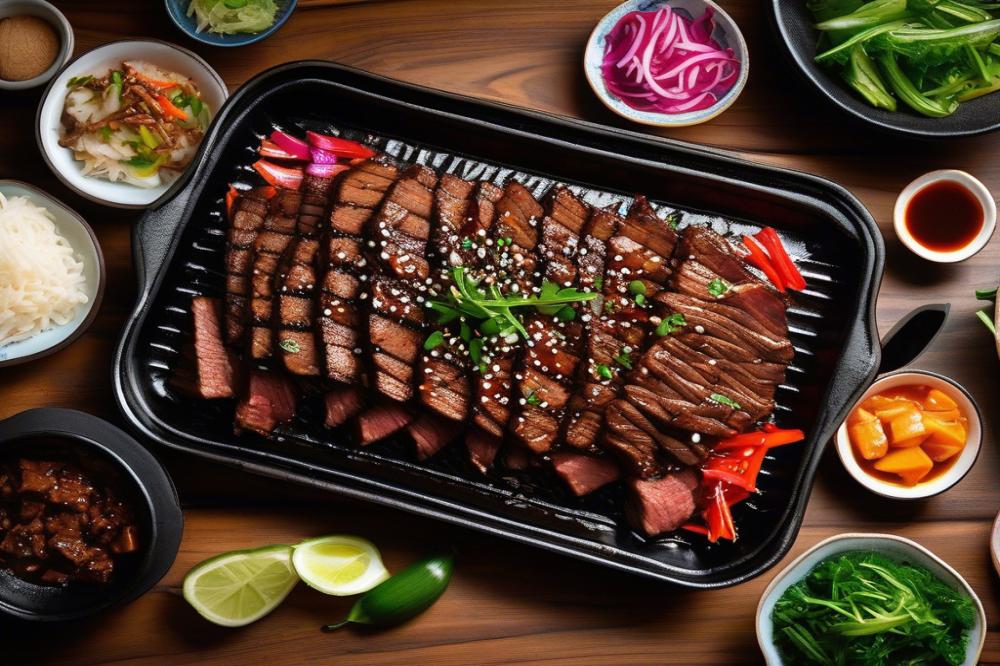Introduction
Bulgogi is a beloved dish in Korean cuisine, known for its delicious flavors and tender meat. This recipe showcases marinated beef that is both savory and slightly sweet, making it a favorite among many. At the heart of its success lies the marinade, which not only enhances taste but also improves the texture of the beef. Ingredients like soy sauce, sesame oil, and a mix of vegetables create a rich flavor profile that brings the dish to life.
Marinating beef is essential. This process allows the meat to absorb the flavors deeply, resulting in mouthwatering bites. A well-marinated piece of beef will be more tender and juicy. Grilling is a popular method for cooking this dish, as it adds a delightful char and smoky flavor. There’s something special about the sizzling sounds and aromas that waft through the air when the beef hits the grill.
Many enjoy serving Bulgogi with a variety of side dishes. From fragrant rice to fresh vegetables, these accompaniments elevate the meal. Whether you’re cooking for a celebration or a weeknight dinner, this Korean BBQ can impress anyone. Let’s dive into the details of preparing this iconic dish, ensuring you can recreate its delightful flavors in your own kitchen.
Understanding Bulgogi
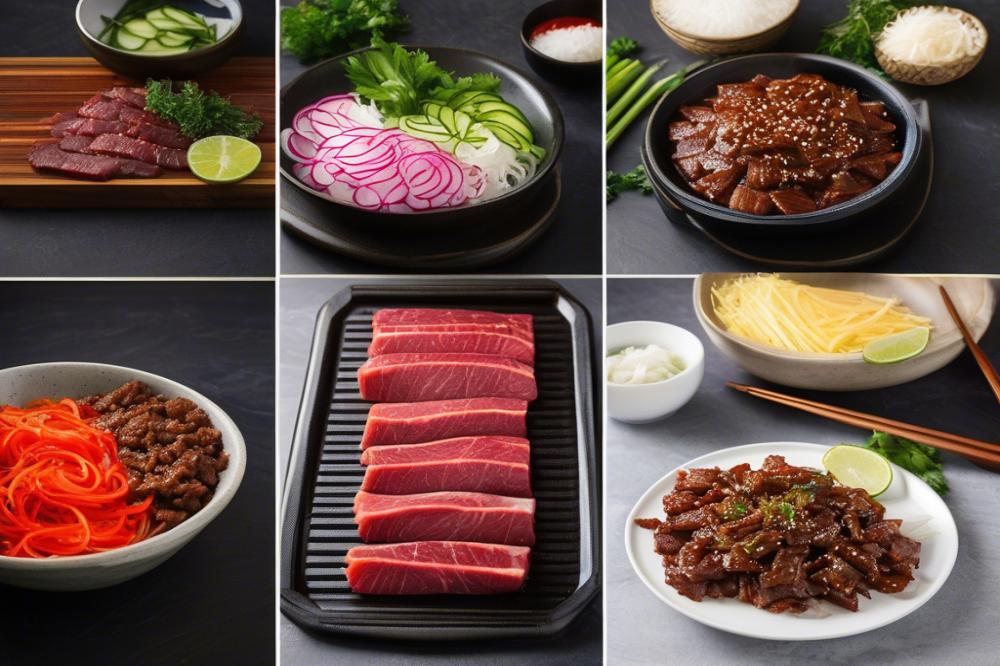

Bulgogi is a popular dish in Korean cuisine, made primarily from beef that is marinated and then grilled. The term itself translates to “fire meat,” emphasizing the cooking method. This dish has a rich flavor profile, thanks to a marinade that includes soy sauce and sesame oil, along with other ingredients. The result is incredibly tender meat, often served with vegetables or side dishes.
Historical Background and Cultural Significance
This dish dates back to the Goguryeo era, which was over 2,000 years ago. In those times, it was a dish enjoyed by both royalty and commoners. Celebrations and special occasions often featured bulgogi, highlighting its importance in Korean culture. Its preparation reflects values of sharing and hospitality. Families frequently come together to enjoy this meal, making it a bonding experience. Festivals and gatherings regularly include this dish, emphasizing its place in Korean culinary traditions.
Variations of Bulgogi Across Regions
Diverse regions in Korea offer unique twists on the basic recipe. For example, in Jeolla-do, sweet potato starch can be added for texture. In contrast, areas closer to the coast might incorporate seafood alongside the beef. Each variation showcases local ingredients and cooking techniques. In some places, the marinade might include fruits like pear, which adds a natural sweetness to the beef. Whether cooked on a grill or in a pan, the variations speak to the creativity of Korean cooks across the nation.
Ingredients List and Cooking Instructions
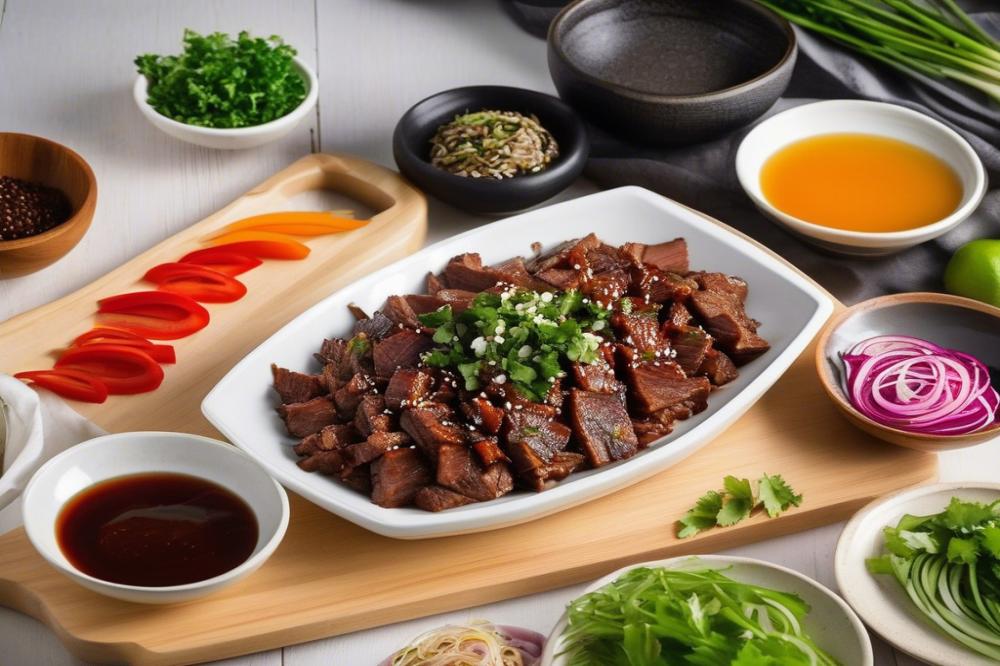

Cooking a delicious meal like Korean BBQ beef requires the right ingredients. Gather the following items to create this flavorful dish:
- 1 pound beef ribeye or sirloin, thinly sliced
- 1/4 cup soy sauce
- 2 tablespoons sesame oil
- 2 tablespoons sugar
- 4 cloves garlic, minced
- 1 tablespoon ginger, grated
- 1/4 cup green onion, chopped
- 1 teaspoon black pepper
- Optional: sliced vegetables (carrots, onions, mushrooms)
The marinade is essential for achieving the right taste. Start your culinary journey by preparing the mixture that will soak into the beef. Combine soy sauce, sesame oil, sugar, minced garlic, grated ginger, chopped green onion, and black pepper in a bowl. Stir well until the sugar dissolves into the liquid. This marinade not only adds flavor but ensures the meat remains tender and juicy.
Next, place the sliced beef into the marinade. Allow it to sit for at least 30 minutes, but marinating overnight will yield even better results. During this time, the flavors will penetrate the beef, enhancing its taste.
When the time comes to cook, preheat your grill or skillet over high heat. The goal is to get a nice sear on the meat. If you chose to include optional vegetables, you can add them to the grill as well. Carefully place the marinated beef onto the hot surface. Cook for a few minutes on each side, watching closely. You want to achieve a beautiful caramelization while ensuring the tender meat is cooked through.
Finally, serve the bulgogi hot. Pair it with steamed rice and your choice of side dishes. This combination brings brightness and balance to your meal. Enjoy sharing this delightful experience with family or friends!
Nutritional Information
As you savor your Korean BBQ beef, it’s also good to know the nutritional information. Each ingredient offers a unique set of benefits:
- Beef ribeye or sirloin: Rich in protein, iron, and essential vitamins.
- Soy sauce: Contains sodium, which enhances flavor but should be consumed in moderation.
- Sesame oil: Offers healthy fats and antioxidants.
- Sugar: Adds sweetness but is high in calories.
- Garlic: Known for its health benefits, including immune support.
- Ginger: Aids digestion and adds a spicy kick.
- Green onion: Low in calories and rich in vitamins.
- Black pepper: Contains piperine, which can enhance nutrient absorption.
- Vegetables: Contribute fiber, vitamins, and additional nutrients.
Cooking Tips for Perfect Bulgogi
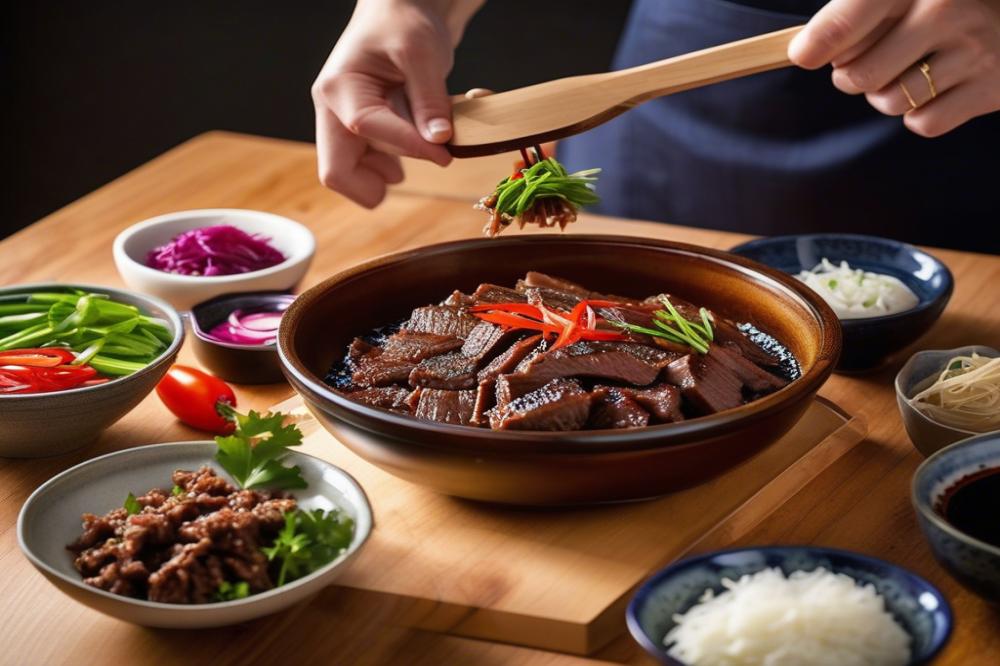

Recommendations for Selecting the Right Beef Cuts
Choosing the right cuts of beef is crucial for flavor and texture. Look for cuts that are known for their tenderness, such as sirloin or ribeye. These selections usually have enough marbling, which adds to the juiciness when cooked. Avoid lean cuts, as they may turn tough. The right beef will absorb the marinade well and become exceedingly tender after cooking.
Tips for Achieving the Ideal Marination Time
Marinade plays a vital role in infusing flavor into the meat. A marination time of at least 30 minutes is recommended, but for the best taste, consider letting it sit for 2 to 3 hours. You may even let it marinate overnight in the fridge. The longer it sits, the more the soy sauce and sesame oil penetrate the meat. This gives the beef a deeper flavor profile, making your dish more enjoyable.
Importance of High Heat for Grilling
High heat is essential when grilling to achieve that perfect char on the meat. When the temperature reaches high levels, it seals in the juices and creates a delicious sear. This grilling method also enhances the flavors, giving the beef a smoky profile. Using a hot grill or skillet can contribute to the overall taste, making it a standout in Korean cuisine. Make sure your grill or skillet is preheated well before adding the marinated beef.
Suggestions for Cooking Equipment
The choice of cooking equipment can influence the outcome significantly. A charcoal grill is excellent for an authentic smoky flavor; however, a gas grill or stovetop skillet can work just as well. A cast-iron skillet retains heat effectively, providing even cooking. Whether you opt for a grill or a skillet, high heat is the key. For side dishes, don’t forget to prepare vegetables that can also be grilled or sautéed alongside the beef. They complement the meal nicely and add color to your plate.
Serving Suggestions and Side Dishes
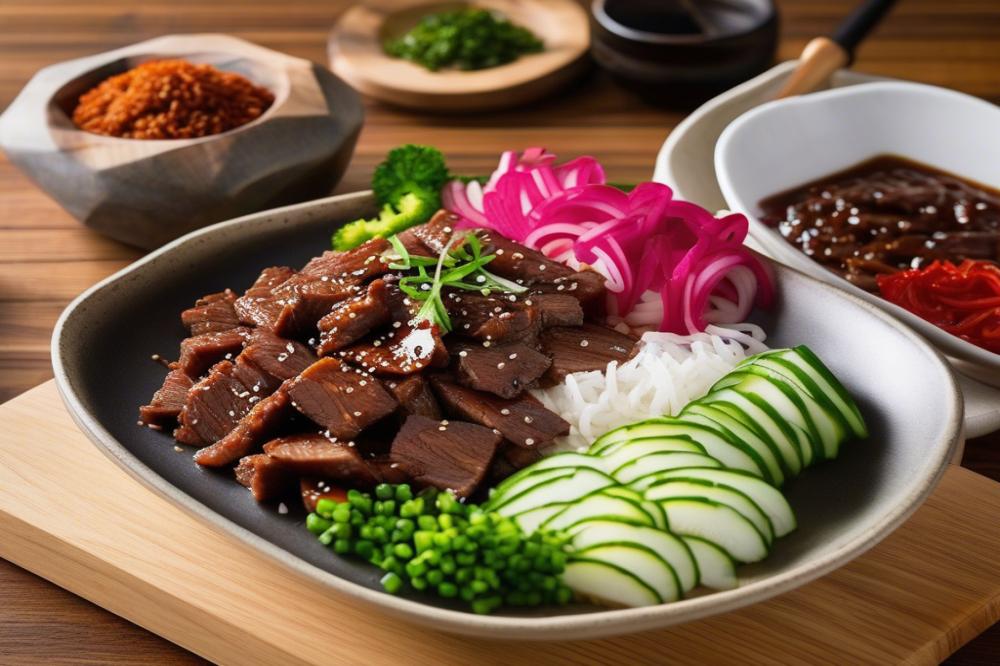

When enjoying Korean BBQ with beef, side dishes play an essential role. They bring balance and variety to the meal. Traditional options include kimchi, pickled radish, and seasoned spinach. Each side dish adds its flavor, enhancing the entire dining experience.
Some people like to serve the tender meat alongside a bed of rice. A simple bowl of steamed white rice complements the savory marinade beautifully. You can also add sautéed vegetables for extra color and nutrients. Stir-fried bell peppers, zucchini, and carrots work well. This combination creates a heartwarming and satisfying meal.
Korean Sauces and Condiments
Many enjoy pairing the grilled beef with various Korean sauces. A popular choice is gochujang, a spicy red pepper paste. It adds a kick to the dish. Soy sauce offers a savory touch, while sesame oil provides a rich aroma. Drizzling these condiments over the beef can elevate the flavors significantly.
Other interesting options include ssamjang, a thick sauce perfect for dipping. It combines fermented soybean paste and gochujang, enhancing the overall taste experience. Using these sauces shows off the depth of Korean cuisine and highlights the unique elements of the recipe.
Wrapping Up Your Cooking Adventure
Preparing a flavorful Korean BBQ dish involves several essential steps. First, marinate the beef overnight or for at least a few hours. This allows the meat to soak up the rich flavors from the seasoning. Next, fire up your grill or skillet. Searing the marinated slices creates that delicious charred taste. Once cooked, serve the beef with fixings like rice, lettuce leaves, and dipping sauces. This simple process ensures that you enjoy a fresh, home-cooked meal.
Trying your hand at making this dish at home can be a rewarding experience. The joy of crafting your own meal, full of tasty ingredients, is unmatched. Friends and family will appreciate the effort, and the delicious flavors can bring everyone together. Don’t hesitate to give it a shot; you might surprise yourself with how well you can replicate this beloved dish.
Additionally, there’s a whole world of classic Korean recipes waiting to be explored. From kimchi to bibimbap, each dish showcases unique flavors and cooking techniques. Delving into these recipes will enhance your culinary skills and deepen your appreciation for Korean cuisine. You are in for an exciting journey filled with delightful tastes and memorable meals.

